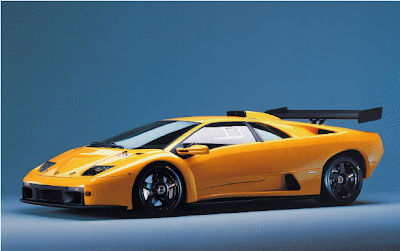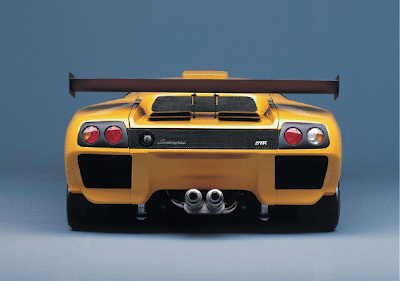The Lamborghini Diablo is a high-performance mid-engined sports car that was built by Italian automaker Lamborghini between 1990 and 2001. It was the first Lamborghini capable of attaining a top speed in excess of 200 miles per hour (320 km/h). Diablo is "devil" in Spanish, which is diavolo in Italian.
Lamborghini Diablo was launched in 1990 as successor to the legendary Countach, carrying on Lamborghini's tradition of naming its cars after breeds of fighting bull. With more money, no wonder the Lamborghini Diablo was better developed than any other previous Lamborghini. In the words of Top Gear presenter Jeremy Clarkson, the Lamborghini Diablo was designed "solely to be the biggest head-turner in the world". Eventually, it survived for 11 years and 2884 cars were built, breaking the record held by Countach. Like Countach and many other Lamborghinis, it was designed by Italian styling maestro Marcello Gandini. No wonder the car had strong resemblance to its predecessor, such as slant front end, steeply raked windscreen and scissors doors.
Lamborghini Diablo GT 2011
During its 11 years life, Diablo evolved gradually. The Lamborghini Diablo GT of 2000 was even developed into a respectable racing machine, pushing performance to the peak. The Lamborghini Diablo SE30 and its optional Jota upgrade kit had been quite sporty and race-oriented, but Lamborghini took this concept a step further in 1999 with its introduction of the very limited production Diablo GT, of which only 80 examples were produced for sale. The Lamborghini Diablo GT was a completely race-oriented model differing in nearly every aspect from the more mainstream Diablos. The cars were fitted with radically altered aggressive bodywork, a stripped-down interior, and an enlarged engine.
Being the street version of the GT2 race car, Lamborghini Diablo GT was the fastest ever Lamborghini Diablo. The V12 was bored out to a full 6 liters. Accompanied with lightweight titanium connecting rods, faster-timing camshafts, individual throttle for each cylinder and enlarged ram-air intakes at the roof, power jumped from 530 hp to 575 hp, while max torque increased from 448 lbft to 465 lbft. That translated to 210 mph top speed. However, two other final drive ratios could be chosen to enhance acceleration while dropping top speed to 199 mph or 204 mph.
Lamborghini Diablo GT 2011
The Lamborghini Diablo GT weighed 1490 kg in dry, 80kg lighter than SV. All body panels, excluding aluminium doors and steel roof, were made of carbon-fiber. In the engine compartment, intake manifolds were made of magnesium, which improved weight distribution to 40:60. Besides, Lamborghini also widened the front track by 110 mm, revised front suspension geometry, stiffened the springs and softened the dampers. The result was more high-speed stability and quicker turn-in at low speed. The new suspension improved handling very much, making it remarkably balanced at cornering limit. The steering feel was terrific, unexpectedly light and accurate, although the car still felt big to handle. Oversteer or understeer could be controlled beautifully by throttle. The GT was the best handling Diablo. What a pity it was a one-off production with only 80 units built.
On the inside, the Lamborghini Diablo GT featured more prominent carbon fiber panels, race-spec bucket seats with 4-point seatbelt harnesses, a smaller steering wheel, and an optional Alpine LCD screen for GPS navigation and a bumper mounted backup camera. Despite the racing pretenses of the vehicle, air conditioning was still installed as standard equipment; airbags could be optionally omitted.
Do you feel that a Ferrari is too soft, too civilized for you? Then go for a Lamborghini Diablo. The Lamborghini Diablo – The story of Lambo Cars. The Diablo is an object of desire, a car that speaks to its owner's heart more than any other car on production today. You can't really understand the size of a Diablo until you actually see one on the road and you surely can't understand the feel of a Lamborghini Diablo until you actually drive it.


No comments:
Post a Comment